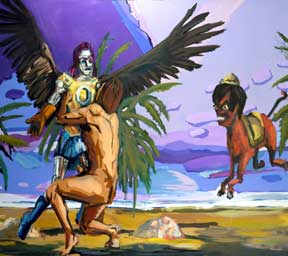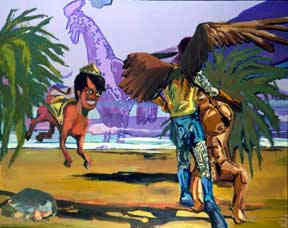|
Twilight- 2002 oil and acrylic- 96x 108 inches |
Journey- 2002 oil and acrylic- 96x 108 inches |
April 5-26, 2002Mario
Diacono Gallery 119 Braintree Street Boston, MA 02134 Painting:
A Genesis by Mario Diacono |
collection of Ida and Achille Maramotti photgraphy by John Morgan image scans by Steve Zitelli installation by Doug Young and Neill Fearnley |
| Jason
Bell's first canvases appear to circumvent all the criticality that has
alternately deconstructed and reconstructed the practice of painting since
the redefinition of Art proposed by Conceptualism. In his work, the pictorial
construction of an image is not a way of making visible Painting's ontology,
nor is a strategy for translating subjectivity into an icon; rather it
seems an act of devotion to the religious impulse to foretell the beginning
of Man and the end of God. In the process, this new painting becomes a
lost-and-found means of visually narrating, with the simplified yet figurally
overcharged wholeness of representation of a comic-book story, the metaphysical
adventures of Primordial Man at the completion of the Terrestrial Age.
This project of practicing the (port)ending of painting by going on a
rummage, on a montage and collage of themes and icons from all layers
of Western and Eastern hermetic/esoteric sources (as Matthew Ritchie had
also done, though with an eye and an ear much more attuned to the history
of Abstraction) in order to image a constant remake of the rise and fall
of God from Idea to Man (and back), bears all the marks of the many descents
of Art, in the Twentieth Century, to the underworld of postures of non-Art,
post-Art and anti-Art that were predicated in much critically inflected
or mass media-minded work. The peculiar descent we see in Bell's work,
of a slice of high culture (the iconography of Hermetism and iconosophy
of Esotericism) into the visual code and narrative modes of popular mythographic
representation, pays then deeper dues than it might at first (in)sight
appear to the erasure of Modernist/Expressive art postulated by ideological
Conceptualism. But such post-Modernistic and Conceptualist allegiance
doesn't result in any proposition by Bell of a pictorial strategy that
would become one more declaration of painting's self-referentiality. The
narrativist and hermetic modes of his pictures result from the artist's
internalization of the 'popular', comic book visual paradigm in order
to forge both a language of representation and the ideography of a neo-Gnostic
anthropogony. |
|
| Since
his last months in art school, about two years ago, Bell had been scribbling
chapters of his syncretistic and humourous anthropogony on large scrolls
of paper using writing, drawing and collage. In these drawings, Tiresias
(9x12 feet), The Birth of a World (8x14.5 feet), The Wars of Gods and Men (7x14 feet),
History's Bastard (llxl0 feet),
Everything Everyone Everywhere (12x51 feet), a cartoonistic/expressionistic
sequential and consequential accumulation of images referencing science
fictional cosmologies, Judeo/Christian theologies, comic book religions
and epics, kabbalistic and magical hierographies, Alchemical symbologies
was scattered over a monochromatically painted ground as a deliberately
non-linear, asyntactical narrative of hypersemantic vignettes. Which were
always linked however by a subliminal intertext positing an originating
event - a sort of iconographic Big Bang - to the story of these images:
the Idea of a Primal Man igniting a chain reaction of iconic implosions
of all the histories of the birth of History. The interplay of High (content)
and Low (form) had been of course a recurrent temptation and aesthetic
necessity of Twentieth Century avant-gardes, since it was the inevitable
shorthand/shortcut for acknowledging new social realities with attendant
new typologies of economic expression and cultural formation. In the early
'Sixties, Lichtenstein and Fahlstrom had transposed into a conceptual
template for their work the structure of the comic-strips' narratives.
Bell hasn't even tried to approximate their sublimation in a 'high' style
of the 'low' statute of the comic book or comic strip visuality. He might
be in this sense much closer to Basquiat than to the Pop artists. His
internalization of the comic book paradigm of representation was so complete
that if one could have disregarded the esoteric sources and intentions
of his graffited, science-fictional and mythographic iconography, one
would have practically noted almost no differences. For Bell, both his
mimicking of a'low' mode of representation, and his 'pastiching' of the
'high' concepts in Hermetic ideographies and narratives, were an acknowledgement
of religious/artistic belatedness and at the same time a primal attempt
to infuse painting with the different effect of a multitextual complexity. |
|
| Twilight
and Journey, the two paintings exhibited here (both oil
and acrylic on canvas, 2002, 96x108 inches) not only diverge from the
large drawings by moving from one (low) medium to another (high) medium,
but also abandon their sequential narrative to focus on a single image,
which is the same in the both pictures, but seen from two opposite points
of view: as if the spectator were able to move 180 degrees around the
scene of Twilight, and could thus see what lay behind the artist's back - the scene
of Journey. This "bi-located" scene is primal
not only in a mythoreligious sense - the confrontation of God and Man
in a tropical Paradise -, but maybe in the Freudian one as well. In Journey
the Primordial Man, Adan or Nada, is kneeling next to a rock - a sort
of Delphic omphalos, holding on to or struggling
with a booted Angel hugely winged, yellow-shirted and blue-skirted, possibly
just arrived from outer space (his feet are not touching the ground, as
any angel in a Renaissance Annunciation). The image takes place on a continent
the size of an island, since we see water all around; the Angel's probably
fresh arrival is confirmed by the presence in both pictures of a fantastic
horse, modeled on al-Buraq, the mount with a crowned human head on which, according
to the Miraj Nameh legend, the Prophet Mahomet had ascended to the seven
Heavens and reached the Throne of God. The inscription of the Miraj text
is reinforced (even if the image in Bell's pictures shows a descent of
God to Man rather than an ascension of Man to Heaven) by the phantasmatic
appearance in Journey, at the edge of the water, of a purple/violet cock
whose single comb reaches the sky while his feet rest on the island's
ground. Further, the Miraj text is interlayered in the two canvases with
that of P.J. Farmer's science-fiction novel The
Unreasoning Mask,
in which "the hero Ramstan, a Muslim starship captain in the distant
future, goes through his own ' Miraj
', which takes place solely within his mind". A quotation from a
Nur el-Musafir at the beginning of the novel, "Where there is only
one, there is also another", might further still be used to read
the "bi-location effect" of the two canvases. The two pictures
oscillate then between a physical twilight of God (which includes the
twilight blue of the cock in Journey), and the metaphysical
beginning of Man (the Angel's journey brings to painting in Twilight
the birth of Adan or Nada). The purely functional (to the hypernarrative
of this Genesis) and minimally expressive use of painting in the two pictures
points to a refuse, at least for now, on the part of the artist to be
drawn into the debate of a formalist art - the minimal form of the brushstrokes,
of the layering of paint, of the choice of colors symbolically determined
follows the function of pointing picture-making in the direction of a
supposed (usefully) lost innocence). One last detail in this pictorial
Genesis has to be noted: the Primordial Man appears to be born, as in
almost all myths of the Origins, with a fully developed body, but here
also with a fully developed erection (as in the illustration, published
in the 1521 Italian translation of Vitruvius' De Architectura
[folio G2] and attributed to Leonardo, of the ideal human figure, whose
spread arms and legs touch the four corners of a gridded square inscribed
in a circle, that is in turn inscribed in a larger square). This erection,
rather than naming sexuality as a result of the Genesis, merely points
in Bell's image to the uninterrupted yet always frustrated power of Man
to develop into a Terrestrial God. |
|
| Return to the TETRAGRAMMATRON Home page | |

